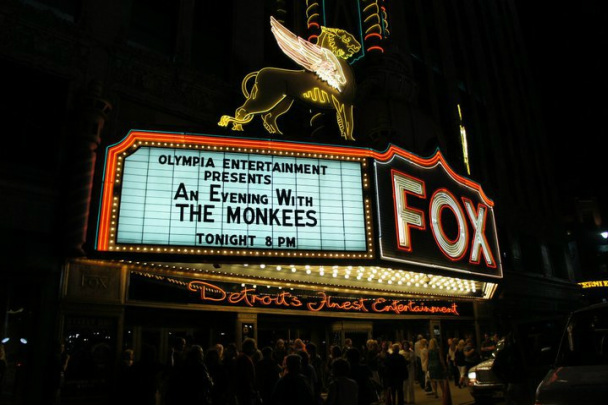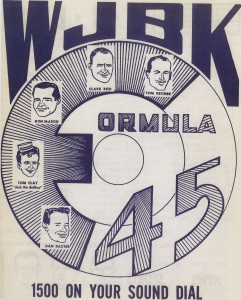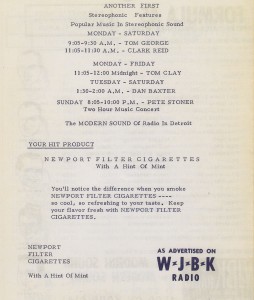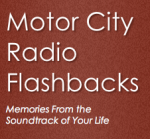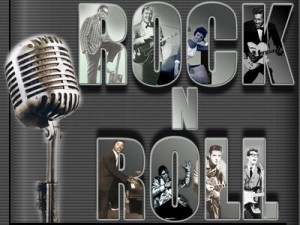![]()
AIRCHECK OF THE WEEK W/: STEVE ROBBINS WKNR ’67
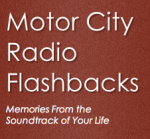 From the MCRFB Aircheck Library: WKNR
From the MCRFB Aircheck Library: WKNR
Steve Robbins on 1310 AM WKNR “Keener 13” 1967
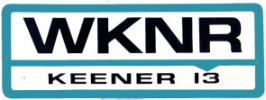 “In Detroit for the first time. You heard their records. You seen them on TV. Now see them in person! The Monkees in person at Olympia Stadium 7:30 Saturday. KEENER presents the MONKEES!” — Paul Cannon, WKNR
“In Detroit for the first time. You heard their records. You seen them on TV. Now see them in person! The Monkees in person at Olympia Stadium 7:30 Saturday. KEENER presents the MONKEES!” — Paul Cannon, WKNR
THE MONKEES ARE COMING! KEENER 13 Brings the Monkees to Olympia, January 14, 1967

….The Monkees are coming, right?…
On Saturday, January 14, 1967, WKNR “Keener 13,” in conjuction with Dick Clark Productions, sponsored the biggest Detroit concert event since WKNR brought the Beatles to Olympia Stadium on August 13, 1966.
…. No. 1., what a perfect song by the perfect group, the Monkees on Keener 13…
When this classic WKNR aircheck was recorded on Friday, January 13, 1967, you can sense the exuberance and euphoria for the anticipated arrival, then, of the band’s arrival here in the Motor City for the very first time.
There was a “lot of excitement around here,” at the station at the time, said Keener deejay Steve Robbins on his show just twenty-four hours before the Monkees would take to the stage at the Olympia, Saturday night, January 14, 1967. The Olympia Monkees event eventually sold out.
Moving swiftly from city to city across the country, the Monkees 1966-1967 North American Tour was such a success that it was extended further into late-August of that year by popular demand. WKNR would again sponsor the Monkees return back to Detroit at the Olympia once again, this time it was scheduled for Saturday, July 29, 1967.
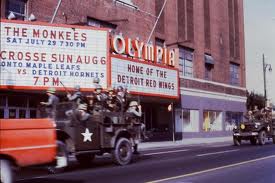
But in the early hours of Sunday, July 23, 1967 Detroit erupted in flames. Due to the civil unrest and local and federal curfews imposed during the riots, the pre-scheduled show was immediately canceled.
Keener deejay J. Michael Wilson issued this WKNR-released statement on Wednesday, July 26 during his 10 PM show:
“Here’s an important announcement regarding the Monkees appearance in Detroit. In case you missed it, the concert at Olympia Stadium scheduled Saturday, July 29 has been postponed. The new date has not been determined at this time. Please hold on to your Monkees tickets. When a new date has been set it will be announced on WKNR. Do not call WKNR or Olympia. Stay tuned to Keener for information regarding the Monkees concert — repeating — the Monkees concert sheduled for July 29 has been postponed. No new date has been set at this point. Hold on to your Monkees tickets and stay tuned to Keener for further information. Do Not call WKNR or Olympia.”

Ultimately, the Detroit-canceled July 29 Monkees concert was rescheduled for Sunday, August 13, 1967 — a year to the day WKNR brought the Beatles back to Olympia in August 1966.
In January of 1967, Keener “fill-in” Steve Robbins was sharing on-air duties on a part-time basis at the WKNR-FM studios, while sharing some air-time there with Keener FM deejay Bob Harper. Just the same, at the time Robbins was still doing his full-time show during the week at WKFR in Battle Creek’s “Keener 14” under the name Steve Clark. When Jim Jeffries left WKNR the latter-part of 1967 for WQXI in Atlanta, Steve left WKFR to become the new overnight deejay on Keener 13.
This week, unexpected news came that Davy Jones, formerly of the Monkees, passed away suddenly at the age of 66 on February 29. But for a just brief moment in time, MCRFB will take you back in 1967 when “Monkeesmania” was widespread and prevalent here in the Motor City and the Monkees and WKNR was at the top at No. 1. “THE MONKEES ARE COMING!”
From the MCRFB Aircheck Library, featuring:
___
WKNR-AM * Steve Robbins * (Monkeesmania!) January 13, 1967
Bob Green talks to Davy Jones of the Monkees, 1967
WKNR-AM * Bob Green * Davey Jones Interview (Monkees) 1967
(Keener deejays 1967 photograph, top, courtesy the Art Vuolo collection)
![]()
Scott Regen – Columnist
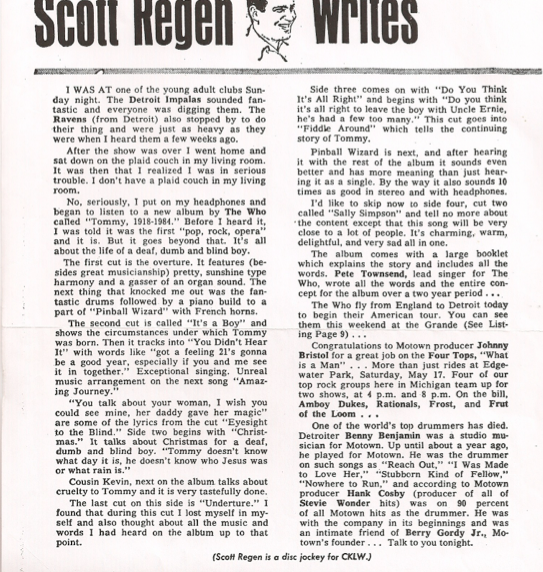
From his CK days, Scott Regen, writing about the Who’s Tommy album for the Detroit Free Press. See more of the Scott Regen Collection at Keener13.com.
![]()
WJBK-AM RADIO 1500 * FORMULA 45 * 1958
A TEENER’S ‘DAYDREAM.’ DAVY JONES REMEMBERED
 HIS FIRST PROFESSIONAL ACTING gig happened when he was eleven. He was a star on the BBC’s Coronation Street at age 16. And when he was 20, Davy Jones was picked from a casting call of thousands to be part of a made-for-television rock band that became one of the most popular acts of the decade.
HIS FIRST PROFESSIONAL ACTING gig happened when he was eleven. He was a star on the BBC’s Coronation Street at age 16. And when he was 20, Davy Jones was picked from a casting call of thousands to be part of a made-for-television rock band that became one of the most popular acts of the decade.
After seeing the film A Hard Day’s Night, Bob Rafelson and Bert Schneider decided to create a TV show that would feature what they hoped would be America’s answer to the Beatles. Their first choice was to sign John Sebastian’s Lovin’ Spoonful, but that group already had a record contract. So they ran an ad in Daily Variety and The Hollywood Reporter in the fall of 1965 to find their musicians.
Americans Micky Dolenz, Michael Nesmith, and Peter Tork, and Brit Davy Jones were ultimately hired and under the guidance of Don Kirshner, the Monkees were born. The group had help from some of the best writers in the business including Tommy Boyce, Bobby Hart, Neil Diamond and the Brill Building team of Gerry Goffin, Carole King. They charted 13 times on the WKNR Music Guide, with hits like “Last Train to Clarksville“, “I’m A Believer“, “(I’m Not Your) Steppin’ Stone“, “Pleasant Valley Sunday” and “Daydream Believer.” They held down Keener Hit Number One five times.
While each Monkee had his fan base, Davy was a particular favorite. With the British Invasion in full swing, his English accent and Beatle hair cut put him at the forefront. 38 years later, Yahoo Music named him “Number 1 teen idol of all time.”
At the height of the Monkee’s popularity, Davy Jones talked with Bob Green about life in the Hollywood spotlight.
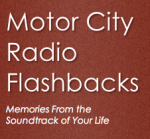 Jones continued to pursue a show business career after the Monkees broke up in 1971, touring with Dolenz, Boyce & Hart and various other side men. His stage and television credits include starring with Dolenz in Harry Nilsson‘s play The Point in London and appearances on, The Brady Bunch, My Two Dads, Here Come the Brides, and Love, American Style. He continued to record, releasing his last album in 2009.
Jones continued to pursue a show business career after the Monkees broke up in 1971, touring with Dolenz, Boyce & Hart and various other side men. His stage and television credits include starring with Dolenz in Harry Nilsson‘s play The Point in London and appearances on, The Brady Bunch, My Two Dads, Here Come the Brides, and Love, American Style. He continued to record, releasing his last album in 2009.
His last performance happened on February 19th in Oklahoma, just ten days before he died in his sleep of a massive heart attack at age 66.
![]()
CKLW-TV 9 ADDS TEEN SHOW . . . JULY 31, 1965
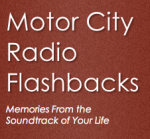 A MCRFB NEWS brief: 1965
A MCRFB NEWS brief: 1965
CKLW-TV Bows Show for Teens
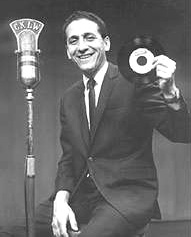 DETROIT — A Canadian TV station, CKLW-TV, which also serves Detroit, has kicked-off an hour daily variety show for teenagers called ‘Swingin’ Summertime.’ Host of the show, which features both live and taped segments, is Robin Seymour.
DETROIT — A Canadian TV station, CKLW-TV, which also serves Detroit, has kicked-off an hour daily variety show for teenagers called ‘Swingin’ Summertime.’ Host of the show, which features both live and taped segments, is Robin Seymour.
Among the artists appearing on the first show were the Rolling Stones, Gene Pitney, Dwayne Hickman, Paul Anka, Deborah Walley and Harry Belafonte. The show is telecast live before a teen audience at the CKLW television studios in Windsor, Ontario. END
(Information and news source: Billboard; July 31, 1965)
![]()
IN DETROIT IT’S ‘SWINGIN’ TIME’ CKLW 9 . . . APRIL 2, 1966
Bandstand TV Scene Bears Watching — The Detroit Scene
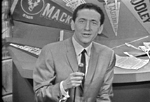
HOLLYWOOD — Teen-age bandstand TV shows come and go–and a couple of important ones met their demise during the past few months — but over-all they seem more popular than ever. Especially at the local level. A quick check of some of the nation’s major bandstand shows found them not only doing well from the advertising sponsorship angle, but in audience ratings.
“Shebang,” for instance, has been sold out the past few months and has a waiting line of advertisers, said producer Bob Burnett. And, though the Los Angeles show is no longer in syndication, it reaches a minimum of more than 4 million daily via CATV distribution throughout Southern California.

Among those national bandstand shows that became drop-outs were ABC-TV’s network “Shindig” show. “Shivaree” dropped out of syndication, but the producers are working on a new format to have it back in syndication next month. The show is now seen in the Los Angeles area.
For the national shows, formats tell the story. A local show can usually do quite well because, as talent-coordinator Art Cervi of “Swingin’ Time” in Detroit puts it, “From the local standpoint, you got a raison d’etre because you’re hitting the people–the kids–who can and do appear on the show. You have an audience participation factor that let’s people identify with you.” The Detroit show out pulls national shows in the market, said Cervi.
The Detroit Scene
“Swingin’ Time” on CKLW-TV, Detroit, is an hour bandstand show during weekdays and the Saturday hour show concentrated on featuring record artists. But so many artists are now seeking to be on the show that talent-coordinator Cervi is using them on weekdays too.
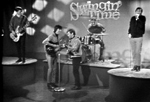
Sponsorship for the show is good. The show is supporting itself and “it looks like its going to do much better,” Cervi said. “I think there’s room for a show like this in every big market. The only trouble some shows run into in various markets is that the markets are saturated with such shows. But we’re doing so well locally that Robin Seymour has given up his radio shows to concentrate on “Swingin’ Time.”
Cervi said his show reaches 85 to 90,000 homes a weekday and around 125 to 130,000 homes during the Saturday show. END
(Information and news source: Billboard; April 2, 1966)
A MCRFB Note: Here’s several videos of ‘Swingin’ Time,’ hosted by Robin Seymour on CKLW-TV 9 in the 1960s. A young Johnny Rivers and Bob Seger enhances as highlights as they appeared on the show. The complete shows features the Supremes and the Rationals when they first appeared on the popular Detroit/Windsor TV dance show.
![]()
FLASHBACK POP MUSIC HISTORY: FEBRUARY 29
Events on this date: FEBRUARY 29
1960: Just four years into his career, Elvis Presley becomes the biggest-selling recording artist of all time, with 18-million records sold, according to an article published today in Billboard. “The King” would go on to sell one billion records in the United States and world-wide.
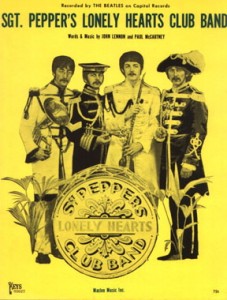
1968: The 10th annual Grammys are held in New York, and the Beatles take home a Grammy for Album Of The Year for their ground-breaking work LP Sgt. Pepper’s Lonely Hearts Club Band for 1967. The Jimmy Webb composition “Up, Up And Away,” recorded by the 5th Dimension, wins both Record And Song Of The Year honors. Bobby Gentry also won big with Best New Artist and two Grammys for her hit, “Ode To Billy Joe.” The biggest winner of the night was Glen Campbell with two vocal awards for “By The Time I Get To Phoenix” in the Best Vocal and Male and Best Contemporary Male Solo Vocal. Campbell was also awarded two more Grammys for “Gentle On My Mind” in the Country and Western Solo Vocal and in the Male and Country and Western Recording categories, not to mention an award was presented to the songwriter for Best Country and Western Song. Aretha Franklin nabbed two awards for “Respect” in the Rhythm and Blues category.
1968: Florence Ballard, having just legally settled during her break-up with the Supremes, marries her first husband, former Motown-chauffeur Thomas Chapman, in Detroit.
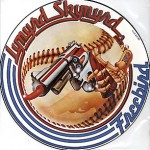 1972: John Lennon’s temporary visa expires, leading Senator Strom Thurmond of South Carolina to send a memo to the Nixon White House suggesting that deporting John Lennon might be “a strategic-counter measure” against his increasing anti-war activism. Around the same time, CIA Director Richard Helms sent a memo to FBI Director J. Edgar Hoover about Lennon’s upcoming “anti-war” tour, which kicked-off a three-year battle for Lennon to stay in the United States.
1972: John Lennon’s temporary visa expires, leading Senator Strom Thurmond of South Carolina to send a memo to the Nixon White House suggesting that deporting John Lennon might be “a strategic-counter measure” against his increasing anti-war activism. Around the same time, CIA Director Richard Helms sent a memo to FBI Director J. Edgar Hoover about Lennon’s upcoming “anti-war” tour, which kicked-off a three-year battle for Lennon to stay in the United States.
1977: While staying at the Royal Lancaster Hotel in London, Lynyrd Skynrd get in a heated argument with members of London’s Metropolitan Police, whose boxing team is staying at the same motel. A fistfight ensued, in which two members of the band are knocked unconscious.
___
(Pop Music events source: oldies.com/)
![]()
‘CK AIRCHECK OF THE WEEK: WALT “BABY” LOVE, ’70
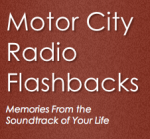 From the MCRFB Aircheck Library:
From the MCRFB Aircheck Library:
Walt “Baby” Love on 800 AM CKLW 1970
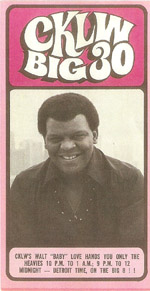 — “CKLW on a solid gold weekend answering a hit line request from Detroit” —
— “CKLW on a solid gold weekend answering a hit line request from Detroit” —
When these Walt “Baby” Love airchecks were recorded in 1970, the Bill Drake era had catapulted CKLW to No. 1 in radio ratings in Motown. The Big 8 was the most listened to radio station in Detroit, Toledo, Cleveland, and in Windsor, Sarnia, Leamington, Ontario and beyond.
With 50,000 watts of pure-enery emanating from the AM 800 transmitter towers outside it’s studios, the nighttime coverage was even more widespread after sundown. Reportedly at times, the CKLW signal could clearly be heard bouncing across four Provinces in Canada and in 28 states. The ‘CK signal had been picked up going far east well into Connecticut, and on some nights deep down into Florida as well.
But it was the Drake-Chenault format that drove the station to the very top. Tight and innovating, it moved faster than the competition drawing more emphasis on the playlist with less talk. By the early 1970s, CKLW was the most listened to radio station here in the Motor City.
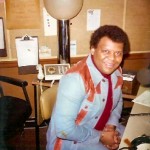 Walt “Baby” Love became the first Black on-air talent at RKO radio, hosting radio shows at CKLW and WOR FM radio in New York City. He has held on-air positions at WNBC, WBLS and 99X, all located in New York City, as well as KHJ, KMPC and KFI Los Angeles. Walt was also Urban Radio and Music Editor at the Radio & Records publication for 21 years.
Walt “Baby” Love became the first Black on-air talent at RKO radio, hosting radio shows at CKLW and WOR FM radio in New York City. He has held on-air positions at WNBC, WBLS and 99X, all located in New York City, as well as KHJ, KMPC and KFI Los Angeles. Walt was also Urban Radio and Music Editor at the Radio & Records publication for 21 years.
In 2005, Walt Love earned a Master of Arts degree in Theology from Fuller Theological Seminary of Pasadena, California. Today, Rev. Walt Baby Love currently resides in Los Angeles with his wife Sonya and son Stephen.
CKLW – WALT “BABY” LOVE – 1970
CKLW – WALT “BABY” LOVE (Scoped) – 1970
![]()
FLASHBACK MOTOR CITY HAPPENINGS ’68 . . . JULY 6, 1968
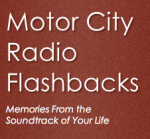 From the MCRFB NEWS archive: 1968
From the MCRFB NEWS archive: 1968
Music Happenings In and Around Detroit Town, 1968
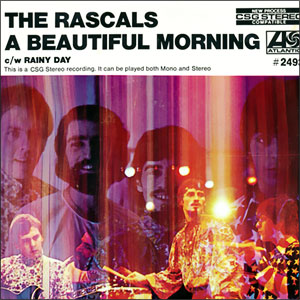 DETROIT — The Rascals are scheduled to perform their first Detroit concert Sunday at Cobo Hall along with Rodney Knight and the Soul Sextex…. Currently appearing at the 20 Grand Driftwood Lounge are the Fantastic Four, the Detroit Emeralds, the Magic Tones, Kris Peterson, and McKinley Jackson and the Politicians…. Tiny Tim appeared at the Edgewater Amusement Park…. Tom Shannon of CKLW radio hosted the Swingin’ Time TV show for vacationing Robin Seymour for two weeks…. Musicor’s Toys were in Detroit the week of June 17 to do promotional appearances for their new recordings…. Chuck Jackson and his revue performed June 22 at Mr. Kelly’s Lounge.
DETROIT — The Rascals are scheduled to perform their first Detroit concert Sunday at Cobo Hall along with Rodney Knight and the Soul Sextex…. Currently appearing at the 20 Grand Driftwood Lounge are the Fantastic Four, the Detroit Emeralds, the Magic Tones, Kris Peterson, and McKinley Jackson and the Politicians…. Tiny Tim appeared at the Edgewater Amusement Park…. Tom Shannon of CKLW radio hosted the Swingin’ Time TV show for vacationing Robin Seymour for two weeks…. Musicor’s Toys were in Detroit the week of June 17 to do promotional appearances for their new recordings…. Chuck Jackson and his revue performed June 22 at Mr. Kelly’s Lounge.
Joe Simon and King Curtis and his band are current attractions at the Phelps Lounge…. WCHB Radio presented its annual “WCHB Talent Contest” on June 22 at the Fox Theater. The first place winner out of 20 contestants was a singing female trio called the Delcavettes. Their prize is a recording contract with Solid Hitbound Productions here. Also performing on the show, intermixed with the contest participants, were Motown acts the Monitors, Shorty Long, Yvonne Fair, and Chuck Jackson. Judges for the contest included Al Kent of Ric-Tic Records, Hank Talbert of Music Merchants Distributors, and singer Gino Washington…. Herb Alpert and the Tijuana Brass appeared in its first Detroit concert June 17 at Cobo Hall. END
___
(Information and news source: Billboard; July 6, 1968)
![]()
